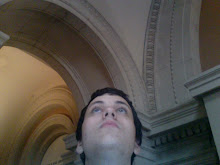もくようびちちとおじいちゃんといとことばんごはんをたべました。わたしはとてもたべものをたべましたよ。おいしかったですね。しちめんちょうやぎゅうにくやじゃがいもをたべました。
It was wonderful seeing my family after not seeing them for a while.
らいげつかぞくをふたたびみます。
But first, finals!!!
Sunday, November 29, 2009
Sunday, November 22, 2009
Hien and David's Senryus
Senryus:
ヤマカンジ
みねはどちらが
ありますか。
(Kanji Mountain
Where does your peak
lie?)
The Katakana of this poem depicts ヤマカンジ as a name, not to be confused with mountain and kanji as two separate words.
スコシあり
オオキイよちで
たちました
(Little ant
In a big world
You stand)
The use of Kanji in this poem was meant to emphasize size difference and extremes. It shows that despite the size of the ant relative to the world, it still stands tall.
ほしのどか
エイエンのなか
あいましょお
(Quiet star
In eternity
We shall meet)
The use of Katakana in this poem is to depict eternity as a unique structure, as a different entity from both the speaker and the star in the poem, neither of which will last in the grand scheme of things.
シチスリク
くにのほうがく
しりません
(City slicker
Country law
You do not understand)
The Katakana and Hiragana of this poem compares the city slicker as a thing apart, believing that he is superior when in fact he is just different, and that there are some pieces which at their core are too far apart to overcome. The use of Katakana here, then, is twofold: it is used to mimic the English, and it is used to convey that core difference between the two through the very way the words are written.
かたかなと
カタカナがどう
わかります。
(Katakana and
Hiragana, how do I
understand?)
The Katakana here is the word Hiragana, and the word Katakana is written in Hiragana, just to show that there are no formal rules in the end of it all, but it is up to the poet to decide.
ヤマカンジ
みねはどちらが
ありますか。
(Kanji Mountain
Where does your peak
lie?)
The Katakana of this poem depicts ヤマカンジ as a name, not to be confused with mountain and kanji as two separate words.
スコシあり
オオキイよちで
たちました
(Little ant
In a big world
You stand)
The use of Kanji in this poem was meant to emphasize size difference and extremes. It shows that despite the size of the ant relative to the world, it still stands tall.
ほしのどか
エイエンのなか
あいましょお
(Quiet star
In eternity
We shall meet)
The use of Katakana in this poem is to depict eternity as a unique structure, as a different entity from both the speaker and the star in the poem, neither of which will last in the grand scheme of things.
シチスリク
くにのほうがく
しりません
(City slicker
Country law
You do not understand)
The Katakana and Hiragana of this poem compares the city slicker as a thing apart, believing that he is superior when in fact he is just different, and that there are some pieces which at their core are too far apart to overcome. The use of Katakana here, then, is twofold: it is used to mimic the English, and it is used to convey that core difference between the two through the very way the words are written.
かたかなと
カタカナがどう
わかります。
(Katakana and
Hiragana, how do I
understand?)
The Katakana here is the word Hiragana, and the word Katakana is written in Hiragana, just to show that there are no formal rules in the end of it all, but it is up to the poet to decide.
Tuesday, November 10, 2009
Composition 2
やまださんへ、
こんにちは。はじめまして。ウェルトマンです。じゅうきゅうさいです。コロンビアだいがくのにねんせいです。だいがくはおおきいですが、きれいです。いそがしいですが、さみしくないです。にほんごのクラスがすきです。
わたしは七月三日ひこうきでにほんへいきます。いまはたらきます。そしてべんきょうします。
よろしくおねがいします。
こんにちは。はじめまして。ウェルトマンです。じゅうきゅうさいです。コロンビアだいがくのにねんせいです。だいがくはおおきいですが、きれいです。いそがしいですが、さみしくないです。にほんごのクラスがすきです。
わたしは七月三日ひこうきでにほんへいきます。いまはたらきます。そしてべんきょうします。
よろしくおねがいします。
Subscribe to:
Posts (Atom)
